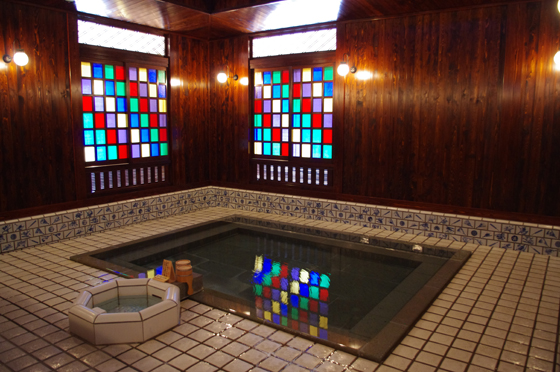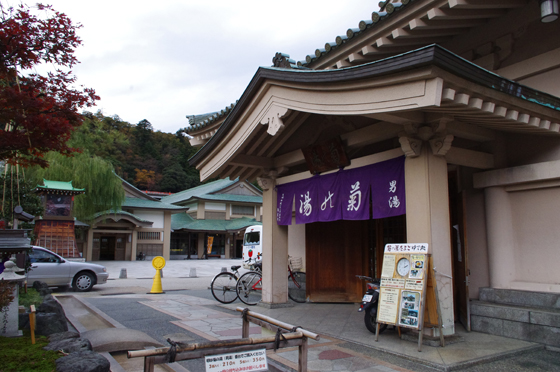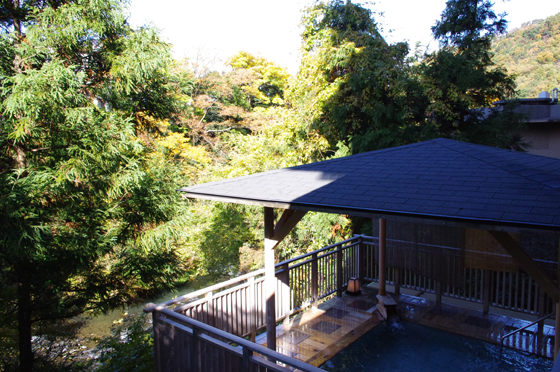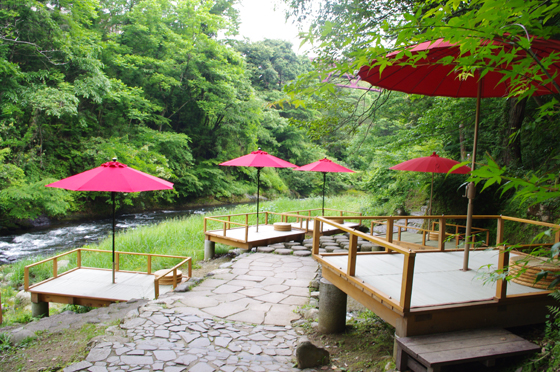Hokuriku Shinkansen Brings Atmospheric Kaga Onsen-kyo Even Closer —Yamashiro Onsen and Yamanaka Onsen at Kaga Onsen-kyo in Ishikawa Prefecture—
The rays of sunlight pouring through the stained glass into the bathtub reflected the numerous colors of the glass on the hot spring water. The bathtub was large enough to take only two or three people at a time. Soaking in the fresh, colorless, translucent spa water, I suddenly noticed Kutani-yaki tiles on the wall. It was as if a refined, graceful breeze was about to blow.

Stained glass in the Kosoyu communal bath at Yamashiro Onsen
This moment occurred in the Kosoyu communal bath at Yamashiro Onsen in the Kaga Onsen-kyo spa resort in Ishikawa Prefecture. Opened in October 2010, the Kosoyu is a reproduction of the Soyu communal bath that was adored as a symbol of Yamashiro Onsen in the Meiji period (1868–1912). The use of soap and shampoo is prohibited, the aim being to enable bathers to have the same experience as people had in the late nineteenth century.
There are two communal baths at Yamashiro Onsen: the Kosoyu, the reproduction of a Meiji-period communal bath, and the Soyu, which is used mainly by local people. When I went to the Soyu at 2 o’clock one afternoon, I found it crowded with local elderly women, some of whom were doing stretching exercises in the bath while others were chatting among themselves. Talk about gossiping around the neighborhood well; this was gossiping in the neighborhood spa! Everyone seemed to be having a good time. Perhaps the most enjoyable thing about spa resorts with communal baths is that you can enjoy taking a dip together with local people.

The Kosoyu communal bath at Yamashiro Onsen

The Kikunoyu communal bath at Yamanaka Onsen
Kaga Onsen-kyo is situated about 40 km to the south of the old city of Kanazawa. The main hot springs in this Hokuriku spa resort fed by the blessings of Mount Haku, an active volcano, are Awazu Onsen, Katayamazu Onsen, Yamashiro Onsen, and Yamanaka Onsen.
Yamashiro Onsen, which is one of my favorites, has a long history going back 1,300 years. Legend has it that this hot spring was discovered by a yatagarasu, a mythological three-legged raven that appears in the eighth-century Kojiki (Record of Ancient Matters) and Nihon shoki (Chronicle of Japan). The general Akechi Mitsuhide (1528–1615) soothed his wounds here, and it was also a favorite haunt of such literary figures as the poet Akiko Yosano (1878–1942) and the novelist Kyoka Izumi (1873–1939). The person with the closest connections to Yamashiro Onsen, however, was Kitaoji Rosanjin (1883–1959), a potter, calligrapher, and gourmet. The owner of the Yoshinoya inn allowed Rosanjin to stay at his private lodge, where Rosanjin crafted his works and in the evenings, seated around a sunken hearth, conversed with the owners of the Shiroganeya, Araya Totoan, and other inns. That building, the Irohaso-an, is still preserved as the site of Rosanjin’s temporary abode, and the hearth where Rosanjin communed remains just as it was. This lodging serves as a reminder of the good old days when hot spring inns treated writers and artists with lavish hospitality.
Furthermore, the townscape of Yamashiro Onsen has been designed so that visitors can sense its long history. The buildings in the Yunogawa hot spring district, which has existed since the Edo period (1603–1868), have been given a uniform exterior of lattice windows (thin strips of wood crossed so that it is easy to see out from inside but difficult to peer in from outside), creating a very atmospheric and picturesque townscape. Incidentally, the Hadutiwo restaurant, which is the center of the local community’s rejuvenation project, serves excellent curry as well!
Yamashiro Onsen is also well known for Kutani-yaki ware, and old Kutani potteries dating from the Edo period still remain. Today there are chic wristwatches that use Kutani-yaki on their dials.

The Kichiyamanaka open-air bath at Yamanaka Onsen
Yamashiro Onsen, which is loved by local people, emits a somewhat sophisticated fragrance. Attracted by this elegant atmosphere, I have visited the spa very often.
Another recommended hot spring at Kaga Onsen-kyo is Yamanaka Onsen, where geisha still entertain guests at inns. Yamanaka Onsen of course also has a communal bath where local people relax, so you can look forward to hot-spring encounters there as well. The greenery of Kakusen Gorge will be very beautiful in the coming months. You can enjoy the scenery by taking a stroll by the river and maybe enjoying a cup of green tea at the riverside refreshment area.

The riverside dining area in the Kasen Gorge at Yamanaka Onsen

The Yamanakaza theater at Yamanaka Onsen
How about taking the newly opened Hokuriku Shinkansen and visiting Kaga Onsen-kyo. The hospitality begins at Kaga Station, where visitors are greeted by “Lady Kagas” (women involved in the local tourist industry) and shops selling local produce. You are sure to receive a warm welcome.
Yamashiro Onsen Tourism Association
http://www.yamashiro-spa.or.jp/foreign/en/
Yamanaka Onsen Tourism Association
http://www.yamanaka-spa.or.jp/global/eng/

What to Take
When I visit onsen, I always take two Japanese tenugui (hand towels) with me. I go to several baths in a day, so I use one towel when I get out of the water at one place and then use the other towel at the next place. Tenugui are most convenient. As well as being light and compact and therefore easy to carry around, they also dry very quickly. Indeed, tenugui have been fondly used by bathers ever since the Edo period. Look at colored woodblock prints of the time, and you will see both men and women coming out of hot-spring baths with tenugui around their necks.
Before Getting in the Bath
A bathe at a hot spring is relaxing, but in the process you actually consume many more calories than you imagine. If you soak in water with a temperature of 42 degrees Celsius for just 5 minutes, it is said that you consume as many calories as you would during a brisk 10-minute walk. So if you enter a bath on an empty stomach, you might feel unwell afterward. At the same time, though, you don’t want to have a full stomach either. So the golden rule is “not too empty, not too full.” I recommend you to eat something beforehand that gives you a quick calorie boost, like chocolate. Ryokan often provide bean-jam buns and green tea in their rooms. Now you know why!
Japanese-Style Bathing Manners
Foreigners should definitely know about Japanese-style hot-spring bathing manners. First of all, when you enter the bathing facility, there will be a changing room. Undress here and leave your clothes in a locker or basket. Women in particular should then tie up their hair in a bun if necessary. In Japan it is considered unclean to let hair get into the bathwater. Next, take your towel or tenugui and go into the bath area. If there are shower booths, wash your body thoroughly there. If not, scoop some water from the bath using a pail and wash yourself. Then you can get into the hot-spring bath. When you are adequately warmed, go back to the shower booth and this time wash your hair as well as your body. Then get into the hot-spring bath again before drying yourself with your towel and returning to the changing room.

- カテゴリー
- Culture、Culture、Hot springs、News、Travel
